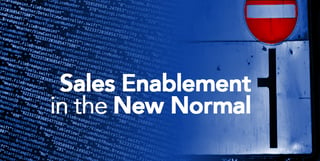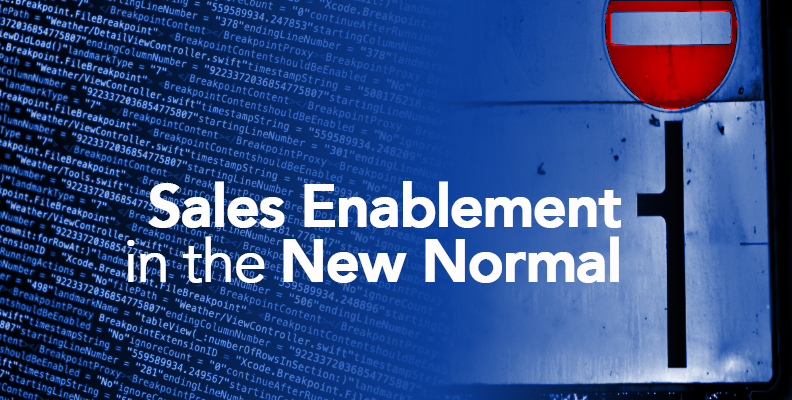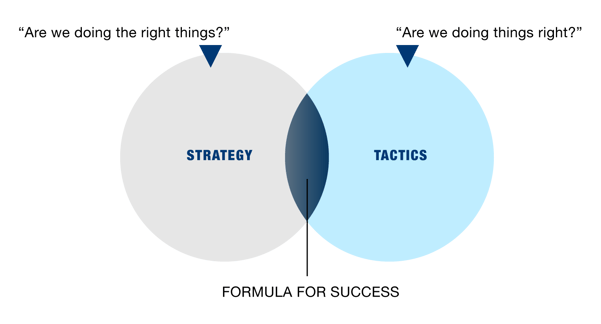

Sales Enablement in the New Normal
Don’t worry, this isn’t another message about how hard ‘these times’ are. We all know how hard it is right now. When it comes to doing business, I’ve never seen a more difficult time. I’m not sure you can stack any more cards against businesses today. Like dining out, attempting to restart sporting events, or reopening drive-in movie theaters, businesses must adapt to the new normal. Part of that adjustment is how Sales Enablement plays a role in companies navigating this storm.
How should sales enablement operate during this new business environment different than how it used to be? For starters, everything must happen faster. Companies must evaluate, pivot if necessary, and adapt... very quickly. Sales enablement must change from being either Instinct-Driven or Data-Drive to become Insight-Driven, agile, and quick to react.
Who's The Client?
To better understand how this change impacts business, we need to understand who sales enablement is actually helping. We need to understand what role sales enablement plays in the success of businesses. If I were to take a poll right now of everyone reading this article, “Who is sales enablements' customer?” I’m fairly certain the answers would be all over the map. That uncovers one problem with this profession (if you would even call it one). Our customer isn’t exactly obvious to everyone in sales enablement. Some might say it’s the senior leadership that is demanding results. Others may say it’s the end consumer. Inevitably, many will agree, it’s the salespeople themselves.
Let’s take a closer look at why a salesperson may be the sales enablement client. If a CEO of company XYZ is held to numbers being set by investors - the biggest focus may be more productivity from the sales team. She would demand the CFO see to it the focus of the next quarter is to hit the numbers needed by pushing hard on sales. The CFO, being a numbers guy, would be more concerned about lowering the cost of sales… causing difficult tasks for all those instructed to increase productivity while decreasing costs.
All of the business leaders, including the product team, HR, operations, marketing, and sales will agree to "get my team on that right away.” Well, the adage, “shit rolls downhill”, will inevitably fall onto the salesperson to make this all happen. What’s left is a ton of activities developed by multiple departments to help sales be successful. They are now equipped with everything from new policies to new playbooks, and anything and everything in between… leaving their heads spinning and a jumbled mess of activities with no clear coach calling the plays. That's where sales enablement takes the ball and scores. (Let's just keep this analogy rolling!) This leads us to change it up in the new business environment.
Why Must Sales Enablement Change?
If the result of all of this activity costs a company tens, if not hundreds of thousands of dollars per salesperson, the investors are left with red flags pointing to the majority of spending on sales and marketing subtracted from the revenue earned, leaving them to focus on the operating margin. According to the large equity firm TCV, investors are starting to care about productivity. They have introduced a new metric to help companies improve their productivity, called the Commercial Ratio.
“This ratio helps us align strategy and tactics while, at the same time, get functional leaders to improve how they communicate with each other.” (Scott Santucci - Growth Enablement, 2020.)

Companies can use this ratio to determine if they are investing enough into sales and marketing to be either too much, meaning unsustainable or a very small number, not investing enough - a rather large number, or balanced. This ratio can uncover where to focus efforts on whether to fix the salespeople or treat the symptoms. Rather than focusing on the strategy or the tactics, sales enablement must now focus on the intersection between the two.
A New Lens
As I mentioned above, we must now go from being instinct- or data-driven to now being insight-driven. For instance, a firefighter may be instinct-driven. Similar to a fire-fighter, a sales enablement professional is consumed by putting out 'fires' all day and spends too much time reacting. A data-driven environment, or paralysis, feels like you’re drowning in operational stats and is slow to move without the data. However, an insight-driven culture is agile. Here, the team leverages, data plus the reality of the situation, plus their expertise to provide executable insights.
The new normal begs us to ask “Are we doing the right things?” of our strategy, in addition to “Are we doing things right?” of our tactics. These two questions’ intersection is now the formula for success. (Santucci, 2020)

What Does This Mean for My Company?
So, what am I trying to tell you about sales enablement in the new normal? In a nutshell... you must ask the hard questions about where to cut out the waste. Keep what your company needs, and prioritize your productivity and cost to drive change quickly. Speed is key here. If you weren't able to move fast prior to 2020, you better be ready to dance now. I guess when someone asks what sales enablement is or does, now you can simply tell them, "We're your dance instructors!"... Tango, anyone?